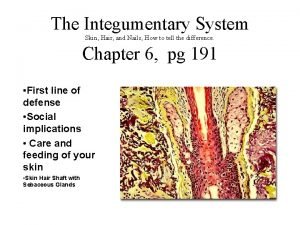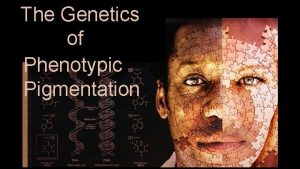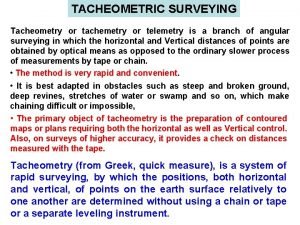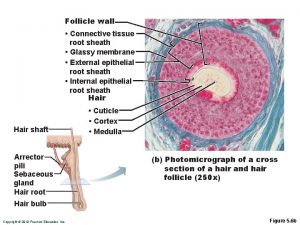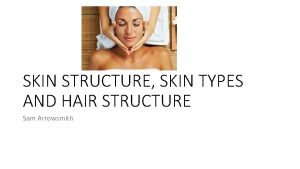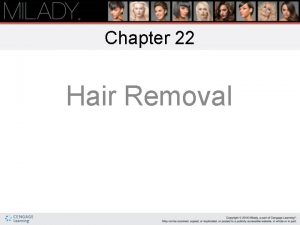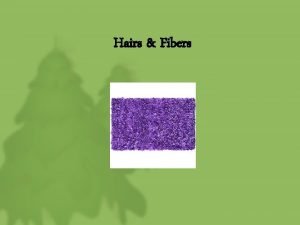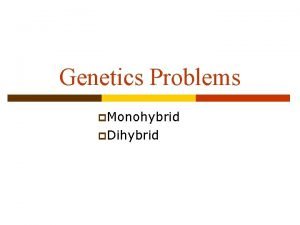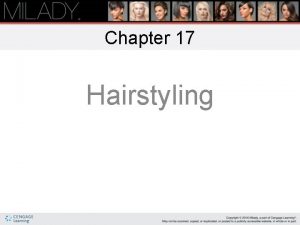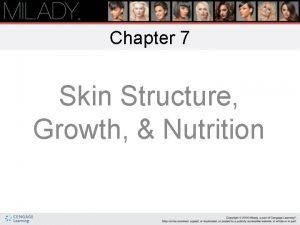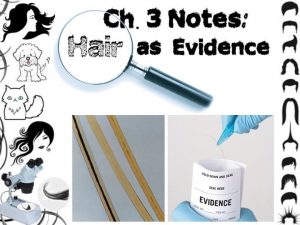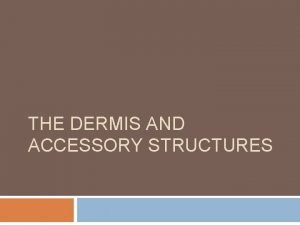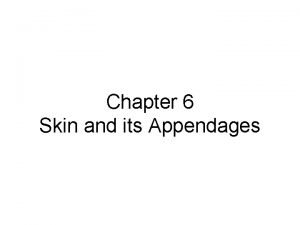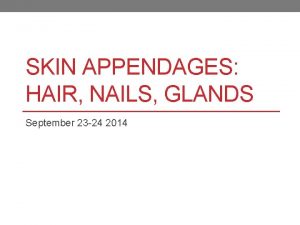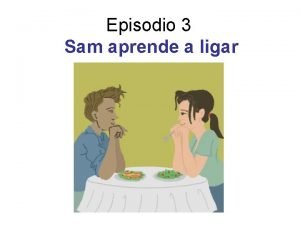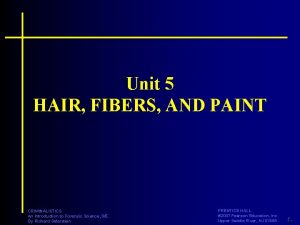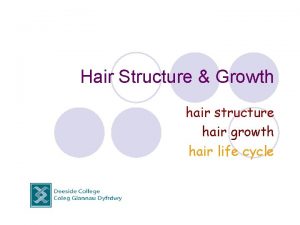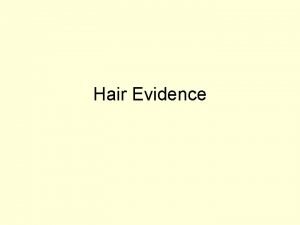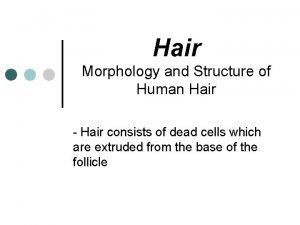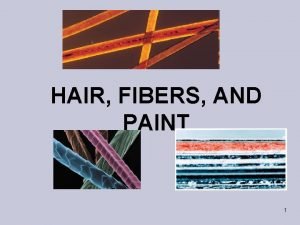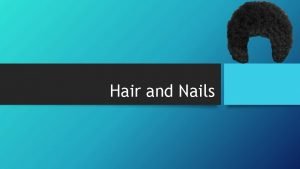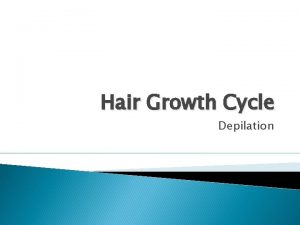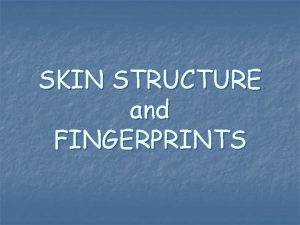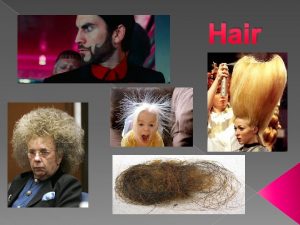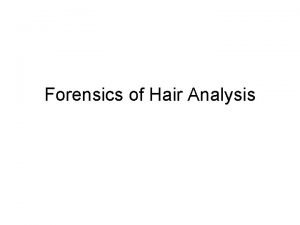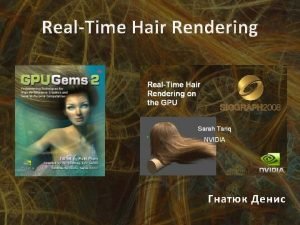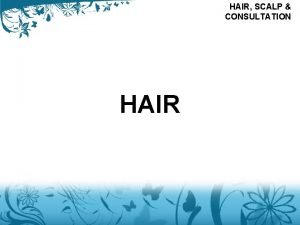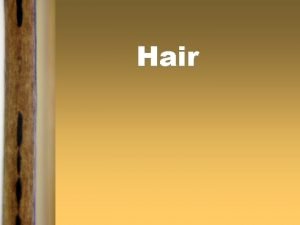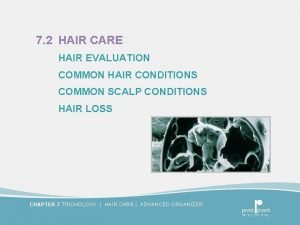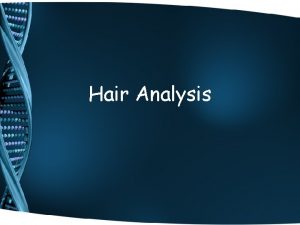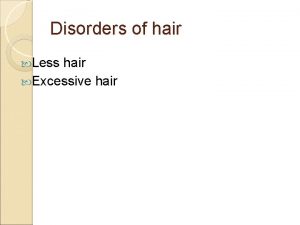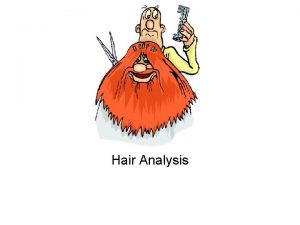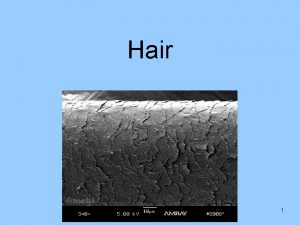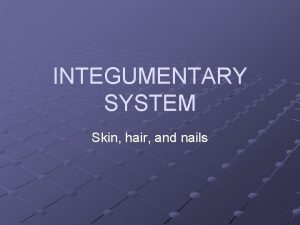SKIN STRUCTURE SKIN TYPES AND HAIR STRUCTURE Sam





































- Slides: 37

SKIN STRUCTURE, SKIN TYPES AND HAIR STRUCTURE Sam Arrowsmith

COMPONENTS OF SKIN STRUCTURE • Skin is the largest organ in the body • It is made up of three layers – Epidermis, Dermis and Subcutaneous layer

EPIDERMIS • Consists of five layers • Surface layer – Statum Corneum – consists of flat, dead hard keratinised cells, constantly sheds through desquamation, has an invisible cell membrane • Clear Layer – Stratum lucidum – cells have no nucleus but are not completely hard, found only on the palms and sole, cell membrane becoming visible • Granular – Stratum granulosum – Cells have a nucleus but cell membranes are dying, contains granules which are visible in tissues that are healing after injury • Prickle cell layer – Stratum spinosum – Cells have fibrils which interlock. The cell membranes are intact, the cell is living • Basal layer – Stratum germinativum – Cells are living, dividing and reproducing (mitosis), This layer contains a pigment known as melanin that gives skin its colour, the cells that produce melanin are called melanocytes. • It takes between 28 -30 days for the cells to reproduce and move up through the five layers of the epidermis before they are shed. (skin renews itself every 28 -30 days)

DERMIS • Known as the true skin. • This layer is connected to the nerves, blood and lymph supply. It contains sebaceous and sweat glands, hair follicles and many living cells. • There are two parts of the dermis - The top layer – Papillary layer and the bottom layer – Reticular layer • The dermis is made of connective tissue mainly areolar (elastic and tough) It contains white collagen fibres (plumps the skin) and yellow elastin tissue (keeps skin elastic and supple) • Specialised cells called fibroblasts are responsible for the production of areolar tissue, collagen and elastin. • Ultraviolet light can damage fibroblasts

DERMIS CONTINUED • Sensory nerve vessels – alerts the brain to heat, cold, pain and pressure ensuring the body responds appropriately – they are part of the body defence system • Lymph vessels – lymphatic capillary works with the blood supply to carry waste products from an area • Sweat glands – travel from deep in the dermis to the outer layer of the dermis. Sweat consists of water, salts and urea. Sweat is produced from two different glands: • Eccrine glands– found all over the body – excrete watery sweat to cool the body • Apocrine glands – found in the armpits (axillae) and the groin – excrete milky fluid, when it mixes with bacteria on the skin it produces body odour • Sebaceous glands – Connects with hair follicles and produces a fatty acid called sebum which lubricates the hair shaft and keeps skin moist – found in hairy areas of the skin • Hair follicles – Travel through the epidermis to the dermis – tiny muscles called erector pili are connected to each hair, they pull each hair upright to trap a layer of air (goose pimples) when the body is cold – helps with temperature control • Pailla – contains nerves and blood vessels which supply the hair with nutrients – conical projections at the base of the hair • Blood supply – Blood vessels such as capillaries, veins and arteries run through the dermis supplying, the body with oxygen and nutrients

Collagen • Collagen is a protein made up of aminoacids, which are made of carbon, oxygen and hydrogen. Collagen is a protein which is found in your muscles, skin, blood, bones, cartilage, and ligaments Collage promotes skin elasticity, holds together your bones and muscles, protects your organs and provides structure to joints and tendons. • Collagen in the skin also protects the skin by stopping absorption and spreading of pathogenic substances, environmental toxins, micro - organisms and cancerous cells. Collagen protein is the cement that holds everything together.

Sensory nerve endings • Found in the dermis layer of the skin and are part of the bodies defence system. They are responsible for the sensations we feel and alert the brain to heat, cold, pain and pressure and make sure the body responds correctly. • There are four main types of receptors.

Lymph Vessels • The lymphatic system is an intricate network of tissue and organs made up of lymph vessels, lymph nodes and lymph that assist your immune system and act as your body's drainage system. This system is located just below your skin and works to ensure the body is able to properly cleanse, detoxify and maintain fluid levels. The primary function of this system is to transport a watery fluid called ‘lymph” containing white blood cells throughout the body. These white blood cells are key to fighting infection and help the body to get rid of toxins, waste and other unwanted materials. If it is not functioning properly, your skin may suffer from acne, be less elastic and show signs of premature aging and overall, have a flaky texture.

SUBCUTANEOUS LAYER (HYPODERMIS) • Lies below the dermis • It's made up of fat cells (adipose tissue)and connective tissues that house larger blood vessels, lymph and nerves. • This layers function is to act as an insulator as it acts as a shock absorber protecting the bodies organs. • It acts as a passageway for the nerves and blood vessels from the dermis to the muscles and helps to protect the bones and muscles from damage. • Conserves heat

SKIN TYPES • Classification of skin types are determined by genetics and ethnicity • The DNA carried in chromosomes is the factor that programs and influences skin characteristics such: * Follicle size * Skin Thickness * Circulation * Nerve endings

PRIMARY FACTORS DETERMINING SKIN TYPES • The level of lipid (fat) secretions that are produced between the skin cells. • The amount of moisture retained by the skin • The amount of secretion produced by the sebaceous glands.

SKIN TYPES

DRY SKIN TYPE • No visible pores • May have broken capillaries - tendency towards sensitivity • Flakiness • Colour pale • Texture thin • Fine lines - Premature ageing is common, resulting in the appearance of wrinkles seen especially around the eyes, mouth and neck • May feel tight • Skin pigmentation may be uneven, and disorders such as ephelides (freckles) usually accompany this skin type • Milia are often found around the cheek and eye area • Causes – genetics, middle age (although can appear at any age) internal and external factors such as sunbeds • Treatment – stimulate the skin to correct the moisture and oil balance

NORMAL SKIN • Even in colour, fine texture, clear, soft smooth and well balanced • Pore size is small or medium • Moisture content is good • Skin texture is even, neither too thick or too thin • Colour is healthy (good blood circulation) • Skin elasticity is good, when young • Skin feels firm to the touch • Skin pigmentation is even-coloured • Skin is usually free from blemishes • Treatment – generally only needs protection and maintenance

Oily skin type • Appearance –large pores particularly down the T zone, comedones (black heads), pustules (spots with pus) and papules (spots without a head) • Moisture content is high • Skin is coarse and thick • Skin is sallow in colour • Skin tone is good, due to protection of the sebum • Skin is prone to shininess, due to excess sebum production (seborrhoea) • May be uneven pigmentation • Certain skin disorders may be apparent – comedones, pustules, papules, milia or sebaceous cysts • Causes – Over secretion of the sebaceous glands – often during adolescence also affected by the menstrual cycle. It can occur at any time in areas of the face. • Treatment – Using specialised cleansing products and routines seek to unblock the pores. Avoid dehydrating the skin

COMBINATION • Most common skin type • Central panel (‘T’ Zone) will be greasy and congested • Rest of face may be normal or dry

WHAT AFFECTS THE SKIN • ENVIRONMENT • Air conditioning • Extremes of temperature • Central heating • Over exposure to sunlight • Hot baths

How you treat your skin • Sometimes what you are doing is stripping away these • fatty oils, leaving your skin unprotected. • This can be by. . • Excessive use of soap • Incorrect skin care • Shaving incorrectly and the use of incorrect shaving products. • Having an excessive amount of baths and showers • after prolonged periods of time the water breaks down maintain moisture

PRE-EXISTING CONDITIONS • Dermatitis Eczema Psoriasis

POOR DIETRY HABBITS • A poor diet can lead to nutritional deficiencies of. . . • Vitamins A and B which can significantly contribute to dry skin. • Crash dieting • Prolonged illness where blood and lymph are diverted away from surface tissues towards diseased area of the body – reduction of fluid in the epidermis

ALCOHOL, SMOKING, DRUGS • Alcohol draws water from the skin to the circulation in response to a too high concentration of alcohol • Smoking dilates surface capillaries which raises the temperature of the skin and causes dryness • Drugs such as diuretics, antispasmodics, antibiotics and antihistamines have a notable drying effect which can lead to dehydration of the skin

HAIR STRUCTURE • Hair shaft • Your hair shaft is the part of your hair that can be seen above your scalp. It’s made of a protein called keratin, compacted and cemented together. Keratin is a remarkably strong protein, which is very resistant to wear and tear. It is in fact the same material that feathers, claws, nails and hoofs are composed of! Keratin is a sulphur-rich protein, with strong disulphide bonds holding the protein strands together. This plays an important role in any chemical processing like perming and relaxing, as these break disulphide bonds and reset them to a different configuration to change the shape of your hair. • Your hair shaft also consists of hydrogen bonds, which help to give your hair its flexibility. They are weaker and more numerous than disulphide bonds and are easily broken with the application of water. This is what allows you to temporarily change the natural configuration of your hair with heated styling aids after washing. • Your hair shaft consists of three layers: the cuticle, cortex, and medulla.

THE THREE INNER LAYERS OF THE HAIR • Made up of the cuticle, the cortex and the medulla – although the medulla isn’t always present, especially in hairs with a thinner diameter. The outer three layers become the lining of the follicle and form the inner root sheath and basement membrane, around which lie undifferentiated cells. Specific cells in the hair bulb, called melanocytes, make the pigment called melanin that gives your hair its colour.

CUTICLE A protective layer composed of overlapping cells, like fish scales or roof tiles, but facing downwards. The outer cuticle holds your hair in your hair follicle by means of a Velcro-like bond. It also minimizes the movement of water (moisture) in and out of the underlying cortex. However, chemical processes and weathering can lift the cuticle and disrupt this balance. When healthy, i. e. smooth and intact, your outer cuticle gives your hair shine and protects the inner layers from damage.

CORTEX • Forms your hairs’ main bulk and pigment (colour). It consists of long keratin filaments, which are held together by disulphide and hydrogen bonds. The health of your cortex depends largely on the integrity of the cuticle protecting it.

MEDULLA • If present, this consists of a thin core of transparent cells and air spaces

HAIR FOLLICLE • Hair Follicle • A hair follicle is part of the skin that grows hair by packing old cells together. • Attached to the follicle is a sebaceous gland, a tiny sebumproducing gland found everywhere except on the palms, lips and soles of the feet. • The thicker density of hair, the more sebaceous glands are found.

DERMAL PAPILLA • The dermal papilla provides nutrition by extending from the dermis into the hair bulb. The hair bulb is a formation at the bottom of the hair follicle itself, and it is the structure responsible for sprouting the hair shaft up the follicle, past the scalp.

ARRECTOR PILI MUSCLE • Small muscles attached to hair follicles • Contraction of these muscles causes the hairs to stand on end, known colloquially as goose bumps. • Pressure exerted by the muscle may cause sebum to be forced along the hair follicle towards the surface, protecting the hair

SEBACEOUS GLAND • Asmall gland in the skin which secretes a lubricating oily matter (sebum) into the hair follicles to lubricate the skin and hair.

INNER ROOT SHEATH • The inner root sheath is an important structure of the lower part of the hair follicle that surrounds and protects the growing hair. It lies between the hair in the centre and the outer root sheath, and all these three structures are made from the matrical cells of the follicular bulb

COMPOSITION OF INNER ROOT SHEATH • The inner root sheath of the hair follicle is located between the outer root sheath and the hair shaft. It is made of three layers: Henle's layer, Huxley's layer, and the cuticle. . Huxley's layer is in the middle, made up of approximately two rows of flattened cells with granular protoplasm

HENLES LAYER • Henle's layer is one cell layer thick and the cells of Henle's layer acquire trichohyalin granules immediately after they have arisen from the matrix. When they first appear, the granules are very small and cuboids in shape. As the cells move upward, they become elongated vertically and form large homogeneous globules and parallel rods in the upper bulb. In this region the cells undergo hyalinization, a form of degeneration. The nuclei of the cells become indistinct and finally disappear. Unlike the cells in other keratinizing tissues, those of the inner sheath do not decrease appreciably in volume.

HUXLEYS LAYER • Huxley's layer is two to four cell layers thick and undergoes cornification above Henle's layer at the region known as Adamson's fringe. Cornification is the conversion of squamous epithelial cells into a keratinized horny material. In the cells of Huxley's layer, trichohyalin granules first appear at the top of the bulb, at which point the cells of Henle’s layer are completely hyalinized. Some cells without trichohyalin granules send lateral cytoplasmic processes across Henle’s layer and penetrate as far as the axial layer of the outer sheath. These specialized Huxley cells have been termed as Flugelzellen, and represent living bridges of cytoplasm across the dead Henle's layer. All nutrients or energy sources from the outer sheath to the hair root come across these bridges. About midway up in the follicle, the cells of Huxley's layer are hyalinized.

INNER ROOT SHEATH CUTICLE • The inner root sheath cuticle is one cell layer thick and the cells of the inner sheath do not acquire trichohyalin granules until they are about halfway up in the follicle. They are the smallest cells in the follicle and can be recognized even in the lower bulb. Above the bulb, the nuclei of the cuticle cells become elongated vertically. They remain small and compressed up to nearly halfway in the follicle, where they begin to show a few small trichohyalin granules. At this level the cells are somewhat flattened, and the proximal edges become slightly dislocated axially so that they overlap the distal ends of the cells below them. These cells are in opposition to the cells of cuticle of the hair shaft which are oriented upwards, thereby anchoring the hair shaft in place. Shortly after they acquire trichohyalin granules, the cuticle cells become hyalinized and their nuclei fade away. Above the middle of the follicle, the three layers of the inner sheath all become fused and hyalinized. The fully cornified inner root sheath anchors and directs the growth of the emerging hair shaft.

OUTER ROOT SHEATH • The outer root sheath (ORS) is an extension of the epidermal basal layer which envelopes the entire hair follicle (HF). In addition, the ORS contains a number of functional compartments: the bulge, which serves as a reservoir for hair stem cells, and the sebaceous gland, responsible for hair lubrication

CONNECTIVE TISSUE SHEATH • Connective tissue sheath • The connective tissue sheath covers the outside of the hair follicle and is a layer connected with the dermis. Collagen fibres run circularly inside the connective tissue sheath and longitudinally outside of it. Several elastic fibres can be found among these collagen fibres.
 Organum germinativum
Organum germinativum Nail contour nursing
Nail contour nursing Simple columnar
Simple columnar Dark hair and blonde hair parents
Dark hair and blonde hair parents What is tacheometric survey
What is tacheometric survey Glassy membrane of hair follicle
Glassy membrane of hair follicle Canities
Canities Thin skin vs thick skin
Thin skin vs thick skin Chapter 23 facials
Chapter 23 facials Types of hair structure
Types of hair structure What are the most frequent hair removal requests from men?
What are the most frequent hair removal requests from men? Rebel disturbs a class
Rebel disturbs a class Hair grows in diagonal tubes called hair
Hair grows in diagonal tubes called hair Medulla pearl shape
Medulla pearl shape Heterozygous short-hair x heterozygous short-hair
Heterozygous short-hair x heterozygous short-hair Define a primary skin lesion and list three types
Define a primary skin lesion and list three types 4 pin curl bases and their uses
4 pin curl bases and their uses Chapter 7 skin structure growth and nutrition
Chapter 7 skin structure growth and nutrition Sam and verna barriers
Sam and verna barriers Medulla types
Medulla types Middle layer and largest part of the hair shaft in humans
Middle layer and largest part of the hair shaft in humans Accessory structure of the skin
Accessory structure of the skin Structure of thin skin
Structure of thin skin Structure of skin diagram
Structure of skin diagram Kit and sam
Kit and sam Sam and jeremy have ages that are consecutive
Sam and jeremy have ages that are consecutive Cliff notes lord of the flies
Cliff notes lord of the flies Sam and mark
Sam and mark Sam and albie
Sam and albie Types of fibers forensics
Types of fibers forensics Basic hair structure
Basic hair structure What makes hair evidence valuable?
What makes hair evidence valuable? Monocots eudicots
Monocots eudicots Hair composition
Hair composition The scale structure covering the exterior of the hair
The scale structure covering the exterior of the hair Podjela zamjenica
Podjela zamjenica Matoš utjeha kose
Matoš utjeha kose Sam lansing
Sam lansing


